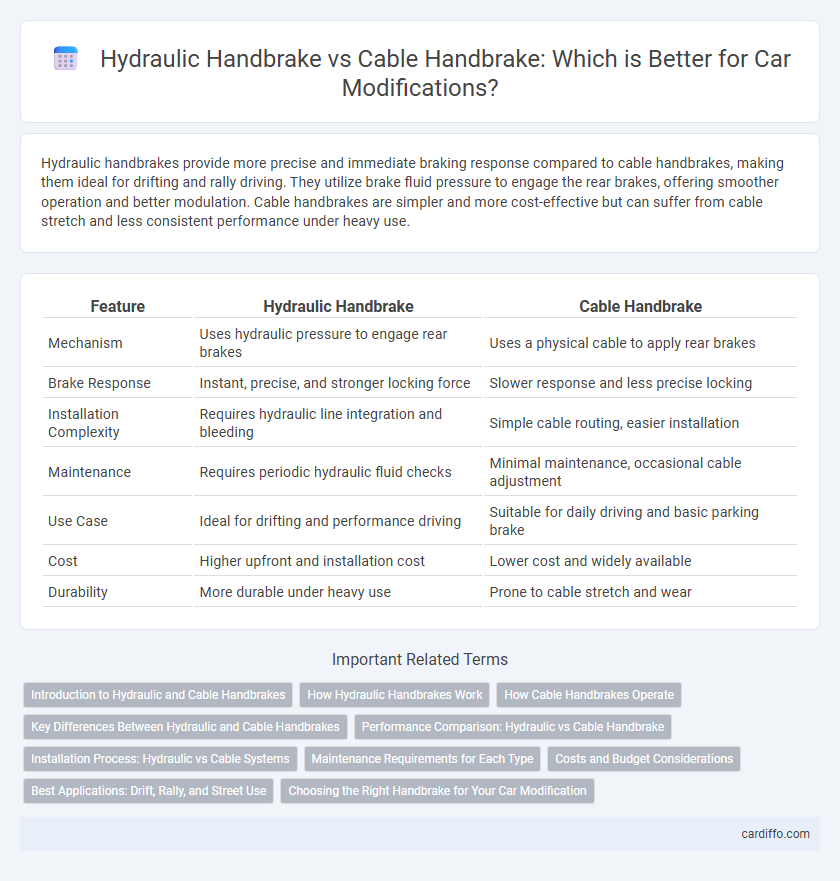Hydraulic handbrakes provide more precise and immediate braking response compared to cable handbrakes, making them ideal for drifting and rally driving. They utilize brake fluid pressure to engage the rear brakes, offering smoother operation and better modulation. Cable handbrakes are simpler and more cost-effective but can suffer from cable stretch and less consistent performance under heavy use.
Table of Comparison
| Feature | Hydraulic Handbrake | Cable Handbrake |
|---|---|---|
| Mechanism | Uses hydraulic pressure to engage rear brakes | Uses a physical cable to apply rear brakes |
| Brake Response | Instant, precise, and stronger locking force | Slower response and less precise locking |
| Installation Complexity | Requires hydraulic line integration and bleeding | Simple cable routing, easier installation |
| Maintenance | Requires periodic hydraulic fluid checks | Minimal maintenance, occasional cable adjustment |
| Use Case | Ideal for drifting and performance driving | Suitable for daily driving and basic parking brake |
| Cost | Higher upfront and installation cost | Lower cost and widely available |
| Durability | More durable under heavy use | Prone to cable stretch and wear |
Introduction to Hydraulic and Cable Handbrakes
Hydraulic handbrakes use fluid pressure to engage the brake system, offering precise control and faster response times compared to cable handbrakes. Cable handbrakes operate via a mechanical cable that directly pulls the brake mechanism, providing a simpler design but often less responsive performance. In automotive modifications, hydraulic handbrakes are favored for drifting and performance driving due to their enhanced modulation and reliability under high stress.
How Hydraulic Handbrakes Work
Hydraulic handbrakes function by using brake fluid pressure to engage the rear brakes directly through a master cylinder linked to the handbrake lever, providing greater stopping power and more precise control compared to cable handbrakes. When the lever is pulled, hydraulic pressure forces the brake calipers or wheel cylinders to clamp the brake pads onto the rotors or drums, effectively locking the rear wheels for better drift or emergency braking performance. This system offers increased responsiveness and reliability, especially in high-performance or modified vehicles where enhanced braking control is essential.
How Cable Handbrakes Operate
Cable handbrakes operate through a mechanical linkage system connecting the hand lever to the rear brake drums or discs via steel cables. When the handbrake lever is pulled, the cable tension increases, forcing the brake shoes or pads against the rotating surface, creating friction that holds the vehicle stationary. This straightforward design offers reliable, direct control and requires minimal maintenance compared to hydraulic systems.
Key Differences Between Hydraulic and Cable Handbrakes
Hydraulic handbrakes offer superior stopping power and smoother modulation due to fluid pressure transmission, making them ideal for precise control in drift and rally applications. Cable handbrakes rely on mechanical cable tension, resulting in a more direct but less consistent feel and generally require more physical effort to engage. Key differences include hydraulic systems providing better durability and adjustability under extreme conditions, whereas cable systems are typically simpler, lighter, and more cost-effective for everyday use.
Performance Comparison: Hydraulic vs Cable Handbrake
Hydraulic handbrakes deliver superior stopping power and more precise modulation compared to cable handbrakes, especially under high-stress driving conditions like drifting or rally racing. Their fluid-based mechanism reduces lag and provides consistent pressure, resulting in quicker engagement and improved control. Cable handbrakes, while simpler and more cost-effective, tend to suffer from cable stretch and less predictable response, limiting their performance in demanding motorsport scenarios.
Installation Process: Hydraulic vs Cable Systems
Installation of hydraulic handbrakes involves integrating a hydraulic master cylinder and brake lines, requiring precise bleeding of the hydraulic system to ensure proper brake fluid pressure and responsiveness. Cable handbrake installation is generally simpler, involving attaching a mechanical cable to the rear brakes and adjusting tension for effective locking. Hydraulic systems offer smoother, more consistent braking performance, but demand more technical skill and specialized tools during installation compared to the straightforward, less technical cable handbrake setup.
Maintenance Requirements for Each Type
Hydraulic handbrakes demand regular inspection of brake fluid levels and seals to prevent leaks and ensure consistent pressure, requiring bleeding to remove air bubbles for optimal performance. Cable handbrakes need frequent adjustment of cable tension to avoid slack and wear on mechanical parts, with periodic lubrication of pivot points to maintain smooth operation. Both systems benefit from routine checks, but hydraulic setups generally involve more complex maintenance due to fluid system care.
Costs and Budget Considerations
Hydraulic handbrakes generally cost more upfront due to the complexity of their components and installation requirements, often ranging between $200 to $500. Cable handbrakes are typically more budget-friendly, with prices around $50 to $150 and easier installation, making them ideal for budget-conscious modifiers. Maintenance costs for hydraulic systems can also be higher, as they involve fluid changes and potential leaks, whereas cable handbrakes require minimal upkeep.
Best Applications: Drift, Rally, and Street Use
Hydraulic handbrakes provide superior control and quicker lock-up, making them ideal for drifting and rally racing where precise wheel lock is essential. Cable handbrakes offer reliability and easier installation, preferred for street use and casual driving modifications. Choosing between hydraulic and cable handbrakes depends on performance needs, with hydraulics favored in competitive motorsports and cables suited for everyday driving.
Choosing the Right Handbrake for Your Car Modification
Selecting the right handbrake for your car modification involves comparing the responsiveness and durability of hydraulic handbrakes versus cable handbrakes. Hydraulic handbrakes offer superior control and quicker engagement, making them ideal for drifting and performance driving, while cable handbrakes provide a simpler, cost-effective solution suitable for everyday use and basic modifications. Consider factors like installation complexity, vehicle type, and intended driving style to determine the best fit for your modification needs.
Hydraulic Handbrake vs Cable Handbrake Infographic

 cardiffo.com
cardiffo.com